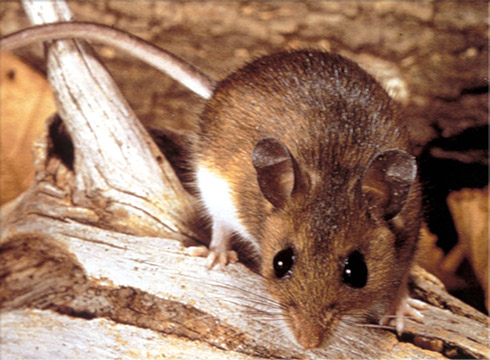
About The Pest
Deer mice (Peromyscus maniculatus) are common throughout New England, especially in rural and wooded areas. Recognizable by their two-tone coloring, they often go unnoticed until the colder months, when they look for shelter indoors. While primarily outdoor rodents, they move inside when temperatures drop to escape harsh conditions.
While they may seem harmless at first, deer mice carry serious health risks. Most notably, they can spread hantavirus (a severe disease affecting the heart and kidneys) and contribute to the spread of Lyme disease through ticks. For many homeowners, the biggest issue is that deer mice stay hidden, building nests in quiet corners and causing damage behind the scenes. This makes early detection difficult and increases the chance of health risks and exposure to harmful pathogens.
What is a Deer Mouse?
A deer mouse is a small, nocturnal rodent found across North America. Adult deer mice measure around four to five inches long and are known for their brown back, white belly, and distinct bi-colored tail.
Unlike house mice, deer mice nest in quiet, secluded areas, where they are unlikely to be disturbed. They are less dependent on human food as other rodent species and can thrive on seeds and insects, so they can be flexible with their habitat choice. Their presence indoors is usually seasonal and often tied to deteriorating outdoor conditions that drives them inside.
About The Pest
The deer mouse seeks cover inside during the winter to escape the elements and search for food. Since deer mice can survive without human food, they often nest away from high-traffic areas, such as kitchens, food prep areas, and pantries. However, like other rodents, they are very resourceful, collecting and storing food over time to consume later when easy pickings are scarce. This species fully matures at around 7- 8 weeks, and can produce up to four litters a year. Deer mice can live for up to two years.
During warmer months, deer mice prefer outdoor habitats. They nest in natural settings, like grassland, woodlands, and shrub-covered areas, seeking out hollow trees, stumps, or burrows in the soil. When colder weather arrives, they seek shelter indoors.
When they move inside, they favor quiet locations such as attics, garages, crawlspaces, and sheds. They build nests using soft materials and store seeds and grains in hidden cubby holes throughout their chosen habitat.
Deer Mouse Characteristics
The deer mouse is easy to recognize if you know what to look for. As described, this little mouse has a soft, brownish back and a white underbelly and feet. Its large black eyes and rounded ears give it a distinct appearance compared to the house mouse.
They are excellent climbers and can squeeze through openings as small as a dime. They are naturally nocturnal and avoid detection by staying hidden during the day. Because of their size and agility, signs of an infestation often go unnoticed until signs like droppings or nests are seen.
Deer Mouse Facts
Here are some interesting facts in a nutshell:
- They can breed year-round, with a peak in spring and fall.
- Females can start reproducing at six weeks old and have multiple litters yearly.
- Although deer mice do not hibernate, they are less active in winter.
- They often build nests using fabric, paper, or insulation.
- These mice can carry hantavirus, which spreads through their droppings and urine.
- Peromyscus maniculatus is the most widespread rodent species in North America.
Seasonality
Deer mice are active all year, but their indoor sightings spike in the fall and winter. As outdoor food becomes insufficient and temperatures fall, they seek warmth and shelter inside. That’s when they’re most likely to enter homes, sheds, or garages.
During spring and summer, they’re more likely to be found in grassland or wooded areas where they can build burrows and forage. Their year-round activity makes them a constant worry, especially where rural and suburban landscapes meet. If in doubt, contact the experts at JP Pest Services, who have local knowledge about rodents, their habits, and behavior.
Why Are Deer Mice A Pest?
Deer mice are a health risk and can damage property. They can spread hantavirus, which becomes airborne when droppings dry out. Their presence also supports tick populations that may transmit Lyme disease.
They can chew through insulation, wires, and storage materials. Because they hide well, a minor problem can grow into something much more serious before anyone notices. While traps may help in the short term, keeping infestations under control often requires a professional approach to finding nesting sites, entry points, and protecting your home.
Frequently Asked Questions
What Is A Deer Mouse, And What Should You Know About It?
A deer mouse is a small rodent with brown and white coloring, often found in rural or wooded areas. It can spread hantavirus and is linked to the presence of Lyme-carrying ticks.
Where And When Are Deer Mice Typically Found?
They live in grassland, forests, and brush outdoors, and enter homes in fall and winter. Inside, they stay in attics, crawlspaces, or garages, away from people and pets.
Are Deer Mice Dangerous?
A: Yes, deer mice can carry hantavirus and support ticks that transmit Lyme disease, posing health risks. They can also cause property damage by chewing wires and insulation.
